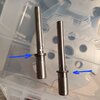Well I feel like I should learn the secret hand shake, after running 100 w/ only 1 hitch. My previous attempts had issues with the primer slide.
Today I loaded 100 9mm - 115 HAP, 4.4 gn N320, Federal 100, in never fired Starline brass. I installed the new gray retainer ring, new gray primer slide and spring, and another primer pin Lee sent me. And I went back to the OEM handle and wooden knob. Reconfigured my dies too, Lee sizer, M-style die, then Lee Auto drum, RCBS lock out die, Mr BF Mini, and Lee all-in-one seating/crimp die.
Only hitch I had was 5th or 6th case didn't receive primer, pretty sure the trough from primer tray wasn't full when I started, and may have contributed to the condition. I honestly can't remember if I felt the primer or not, was busy watching the case slider and for bullets to drop.
So to install the new priming pin I had to take the case feed spring off, I put the spring/screw in the hole closest to the press "front hole", but was unsure how far in/out from the case slider block it should go. The hook over the screw before I took it apart, was vertical, I can't get it back to that position, mine is canted a bit. During this session, there were 5 or 6 cases that sort of shot out ..i.e. they didn't slide. It had to do w/ the spring, but I'm not quite sure what was causing it. It was easy enough to catch the error before they flew across the room though. Hadn't done that before in previous reloading attempts, or while just cycling the press was cases in the case feeder.
The seating was pretty consistent 1.143" - 1.144" was probably 90% of them, there were a few 1.142 and six or so 1.145". That's probably just as good as my 550B.
So Lee sent me 2 new priming pins/springs. When I requested them, that was the day before LiveLife posted Lee was changing them up. The two pins they sent me were different in one way from the original pin that came w/ the press. The collar the spring rests on was thinner, about 40 thous thick, the original pin that collar was 60 thous thick. The OAL, the pin diameters at the face and tail end were the same. The new ones were ever so slightly more rounded on the face, but nothing extreme.

Original pin on left, new one on the right....no idea if that made any difference. From the face of the pin to where the spring rest - old 1.130" - the new one was longer at 1.155". Granted I was using brand new starline brass, the previous attempts were multi-fired range brass, sorted only by headstamp.
The Mr Bullet Feed mini didn't miss a single drop. Someone on the FB group suggested taking it apart and making sure there were no burrs and clean out holes where the ball bearings seat, and I did that - no burrs, and really no grime in their either.
Going to run another 100 or 200 9mm tomorrow, then maybe switch over to 40s&w.




